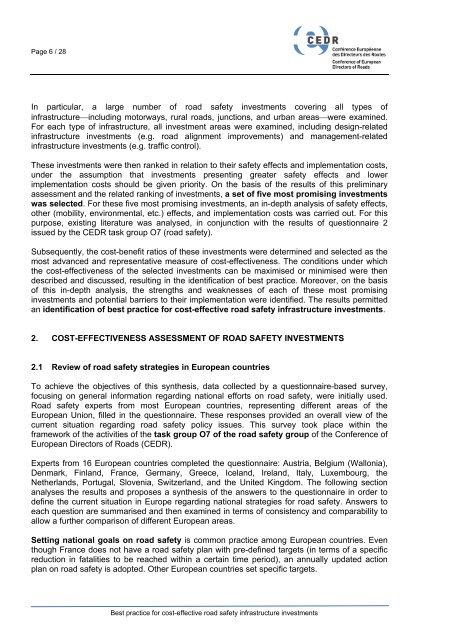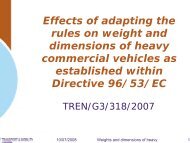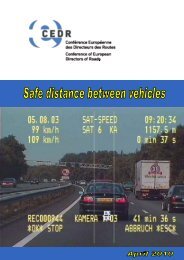Best Practice for Cost-Effective Road Safety Infrastructure - CEDR
Best Practice for Cost-Effective Road Safety Infrastructure - CEDR
Best Practice for Cost-Effective Road Safety Infrastructure - CEDR
Create successful ePaper yourself
Turn your PDF publications into a flip-book with our unique Google optimized e-Paper software.
Page 6 / 28<br />
In particular, a large number of road safety investments covering all types of<br />
infrastructure⎯including motorways, rural roads, junctions, and urban areas⎯were examined.<br />
For each type of infrastructure, all investment areas were examined, including design-related<br />
infrastructure investments (e.g. road alignment improvements) and management-related<br />
infrastructure investments (e.g. traffic control).<br />
These investments were then ranked in relation to their safety effects and implementation costs,<br />
under the assumption that investments presenting greater safety effects and lower<br />
implementation costs should be given priority. On the basis of the results of this preliminary<br />
assessment and the related ranking of investments, a set of five most promising investments<br />
was selected. For these five most promising investments, an in-depth analysis of safety effects,<br />
other (mobility, environmental, etc.) effects, and implementation costs was carried out. For this<br />
purpose, existing literature was analysed, in conjunction with the results of questionnaire 2<br />
issued by the <strong>CEDR</strong> task group O7 (road safety).<br />
Subsequently, the cost-benefit ratios of these investments were determined and selected as the<br />
most advanced and representative measure of cost-effectiveness. The conditions under which<br />
the cost-effectiveness of the selected investments can be maximised or minimised were then<br />
described and discussed, resulting in the identification of best practice. Moreover, on the basis<br />
of this in-depth analysis, the strengths and weaknesses of each of these most promising<br />
investments and potential barriers to their implementation were identified. The results permitted<br />
an identification of best practice <strong>for</strong> cost-effective road safety infrastructure investments.<br />
2. COST-EFFECTIVENESS ASSESSMENT OF ROAD SAFETY INVESTMENTS<br />
2.1 Review of road safety strategies in European countries<br />
To achieve the objectives of this synthesis, data collected by a questionnaire-based survey,<br />
focusing on general in<strong>for</strong>mation regarding national ef<strong>for</strong>ts on road safety, were initially used.<br />
<strong>Road</strong> safety experts from most European countries, representing different areas of the<br />
European Union, filled in the questionnaire. These responses provided an overall view of the<br />
current situation regarding road safety policy issues. This survey took place within the<br />
framework of the activities of the task group O7 of the road safety group of the Conference of<br />
European Directors of <strong>Road</strong>s (<strong>CEDR</strong>).<br />
Experts from 16 European countries completed the questionnaire: Austria, Belgium (Wallonia),<br />
Denmark, Finland, France, Germany, Greece, Iceland, Ireland, Italy, Luxembourg, the<br />
Netherlands, Portugal, Slovenia, Switzerland, and the United Kingdom. The following section<br />
analyses the results and proposes a synthesis of the answers to the questionnaire in order to<br />
define the current situation in Europe regarding national strategies <strong>for</strong> road safety. Answers to<br />
each question are summarised and then examined in terms of consistency and comparability to<br />
allow a further comparison of different European areas.<br />
Setting national goals on road safety is common practice among European countries. Even<br />
though France does not have a road safety plan with pre-defined targets (in terms of a specific<br />
reduction in fatalities to be reached within a certain time period), an annually updated action<br />
plan on road safety is adopted. Other European countries set specific targets.<br />
<strong>Best</strong> practice <strong>for</strong> cost-effective road safety infrastructure investments










